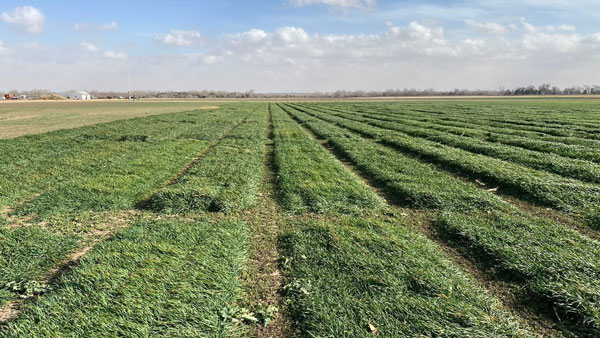Fall forage yield is an important aspect of dual-purpose wheat production. In this system, wheat is typically sown earlier than for grain only production, at higher seeding rates and with additional nitrogen fertilizer to maximize forage production.
The weather experienced during the fall is crucial to determine average level of forage yield, with warm and moist weather typically resulting in greater forage yield than cool and dry weather conditions. Management practices that also maximize forage yield are early sowing, higher seeding rates, placement of in-furrow phosphorus fertilizer with the seed at sowing, and fall nitrogen fertilization.
While the weather is typically the largest player in determining fall forage production, followed by management, there are also differences among wheat varieties in forage production potential. Thus, every year, the K-State Wheat Production Group compares the forage yield of several commonly grown wheat varieties and upcoming lines. This test is usually performed in the South Central Experimental Field near Hutchinson, Kansas (Figure 1), and the forage sampling occurs sometime during December (Table 1).
At the sampling conducted on December 15, 2021, there were significant differences among varieties in terms of forage accumulation. Average forage yield was high (2715 lb dry matter (DM)/a) and with a wide range (from 2119 to 3752 lb DM/a). The varieties that exhibited the highest forage yield were KS Ahearn and KS Hatchett. LCS Atomic AX also had high forage yield with over 3,000 lb DM/a. The high forage yield was function of the combination of an early sowing with good moisture conditions (Figure 1).
Another important aspect of dual-purpose wheat production is how long each variety can be grazed in the spring. This is measured as the date for first hollow stem, and varieties can differ in as much as 20-30 days in achieving first hollow stem in the spring. The Wheat Production Group at K-State uses this very same trial to measure first hollow stem during late February and early March, so keep tuned to the eUpdate for more information on this developmental milestone.

Figure 1. Dual-purpose wheat trial near Hutchinson, KS. The trial was sown on September 21, 2021, with 50 lbs DAP/acre applied in furrow. Weeds were controlled the week prior to sample collection, thus control is still incipient in the photo above. Photo by Romulo Lollato, K-State Research and Extension.
Table 1. Fall forage yield of wheat varieties sown under dual-purpose system near Hutchinson, KS. Forage biomass was collected on December 15, 2021. Data is shown in pounds of dry matter per acre (lbs DM/ac). There were significant statistical differences among varieties at the 5% probability level. Varieties are listed in alphabetical order and the bold text indicates highest forage yielding group. Different varieties with overlapping letters in the “Statistical group” column indicates that varieties did not differ from each other.
|
Variety |
Forage DM yield (lb/a) |
Statistical group |
|
AP Exp#1 |
2479 |
defg |
|
AP Roadrunner |
2119 |
g |
|
AP18AX |
2770 |
cdef |
|
AM Cartwright |
2472 |
defg |
|
Crescent AX |
2941 |
cde |
|
KS Ahearn |
3752 |
a |
|
KS Hatchett |
3689 |
ab |
|
KS13DH0041-35 |
2829 |
cdef |
|
LCS Atomic AX |
3110 |
bc |
|
LCS Chrome |
2304 |
fg |
|
LCS Helix AX |
2337 |
efg |
|
LCS Julep |
2484 |
defg |
|
LCS Photon AX |
2723 |
cdefg |
|
LCS Revere |
2459 |
defg |
|
LCS Runner |
2273 |
fg |
|
LCS Steel AX |
2798 |
cdef |
|
LCS Valiant |
2517 |
cdefg |
|
Plains Gold Ray |
2564 |
cdefg |
|
Zenda |
2962 |
cd |
|
Average |
2715 |
|
|
Min. |
2119 |
|
|
Max |
3752 |
Romulo Lollato, Extension Wheat and Forages Specialist
lollato@ksu.edu
Andrea Gimena Mier, Visiting Undergraduate Scholar
Brahian Nicolas Davila, Visiting Undergraduate Scholar
Jean Lucas Mendes Castro, Visiting Undergraduate Scholar
Guilherme Sueiro, Visiting Undergraduate Scholar
Gaston Olano de Leon, Visiting Undergraduate Scholar
Jorge Armando Romero, Visiting Scholar